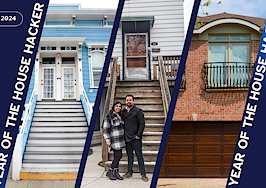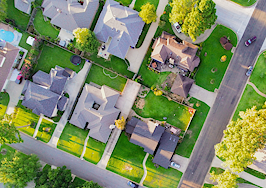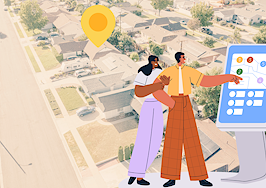This report is available exclusively to subscribers of Inman Intel, the data and research arm of Inman offering deep insights and market intelligence on the business of residential real estate and proptech. Subscribe today.
Far away in the Arabian desert, bulldozers are at this very moment cutting a line. Actually, they’re cutting The Line, which is the name for an experimental new city that, if and when it’s finished, will stretch 105 miles in, well, a straight line.
Saudi Crown Prince Mohammed bin Salman announced the project back in 2021. Today, its website claims the city will eventually run from “epic mountains” across “inspirational desert valleys to the beautiful Red Sea.” It’ll allegedly be “a mirrored architectural masterpiece” with no roads, cars or emissions. Though imagery suggests it’s still in the earliest stages of construction, the company spearheading the project promises that The Line will represent “a civilizational revolution” and become “the city of the future.”
Those are lofty promises.
But, it turns out, the impulse to build a “city of the future” is not unusual. In fact, aside from The Line, there are exotic plans for other “cities of the future” on at least five continents right now. Utopias are having a moment.
All of these projects are a response to various interrelated crises, but in the U.S., one of the biggest is that the country faces a severe housing shortage. The new utopians have gazed out at the lack of housing and the challenges to building it and concluded they might as well just start over.
That raises a question: Will it work? Can “cities of the future” solve our urban problems, including a lack of affordable places to live?
Intel reached out to experts for answers, and the takeaway was that it’s tough to conjure a successful city out of nothing. Many have tried, and many have failed. The flashy PR of projects like The Line notwithstanding, the experts said the kinds of places that we need right now tend to be less newfangled and more historic. In other words, the true city of the future — and the one that addresses today’s urban challenges — may look a lot like the past and fit like a puzzle piece into a place that already exists.
Our problems are legion
That housing faces a challenging landscape right now is no surprise to anyone, but the scope of the problem is eye-popping. One recent analysis, for instance, found that the U.S. currently faces the least affordable housing market since 1984. That same analysis, from analytics firm Intercontinental Exchange, found that it now takes “40.6 percent of the median household income to cover monthly” principle and interest on a home.
The chart below captures this trend, showing that home price growth accelerated significantly in the COVID-19 era.

Credit: Inman via the St. Louis Fed
A big part of the affordability problem is that the U.S. has simply built far too few homes. According to a report that Realtor.com provided to Intel, between 2012 and 2022 Americans formed 15.6 million households. But during that same period, the country only finished building 11.9 million houses. The result is an imbalance of supply and demand,

Credit: Inman via Realtor.com data
which drives prices up.
Though the lines on the chart above never get that far apart, deficits in this case are cumulative, meaning that failing to keep up in one year leads to shortfalls that carry over into the next — something illustrated in the chart below.

Credit: Inman via Realtor.com data
In total, Realtor.com’s data shows that the last decade has produced a shortfall of about 2.3 million homes relative to new household formation.
READ ABOUT HOW ONE CITY ZONED ITSELF INTO A HOUSING CRISIS
The obvious solution to this problem is to increase supply. But thanks to a byzantine regulatory system that generally favors low-density development, as well as bottomless opposition to development from existing property owners, building more housing is a slow and difficult process. Therein lies the appeal of utopianism and cities of the future; it’s a chance to solve the housing shortage while leap-frogging the rules that created it in the first place.
The modern utopians
Among the most famous city-of-the-future projects right now is Telosa. The project doesn’t yet have a site, though Nevada, Utah, or Arizona have all been floated as possible locations. The idea behind the city is to create a “more equitable and sustainable future,” including via communal ownership of land.
Pictures of the project look a lot like Wakanda, the fictional African metropolis from the Black Panther movies.
Credit: City of Telosa
Telosa’s goals are lofty — a city of 5 million people who “always feel safe” and are “always connected to nature” — but the project does have some serious design chops: Danish starchitect Bjarke Ingels.
Alana Goldweit, an associate at the Bjarke Ingels Group, told Intel that the Telosa team analyzed existing cities such as New York, Tokyo and Copenhagen when coming up with their designs. The project consequently values things such as density and the clustering of people near amenities.

Alana Goldweit
“Urban areas that balance density and open space can optimize their infrastructure investments, leveraging a well-maintained accessible green space available to all,” Goldweit said in an email.
Starting from scratch will let the city’s designers prioritize pedestrians and bicyclists, she added, and developing on a huge scale makes much of this possible in a way that it isn’t in existing places.
Telosa is among the more fleshed-out utopian projects out there right now, but it’s hardly alone. Earlier this year, for instance, news broke that a group of Silicon Valley investors were buying up land around the Bay Area with plans to build their own ideal community. The investors include Marc Andreessen and Laurene Powell Jobs’ Emerson Collective.
Elsewhere, the New York Times recently reported on Praxis, which is supposed to be a “crypto-city for tech bros” on the Mediterranean coast. In Japan, Toyota is building Woven City, which will be both a real place for people as well as a testing ground for new technology. And in Toronto, Sidewalk Labs — a sibling company to Google — had been developing a futuristic new area called Quayside, though that project was ultimately abandoned in 2020.
Some of these projects sound pretty goofy. It’s hard to imagine, among other things, people wanting to live in a crypto utopia.
But it’s also tough to quarrel with some of the more serious proposals. Telosa is taking its inspiration after all, from genuinely great cities. If they just build a new New York, a Tokyo or a Copenhagen, they’d probably end with something quite pleasant. But time will tell if it works.
A world of Alexandrias
All of these projects fit into a long tradition of city-building that goes back to the ancient world. Alexander the Great, for example, founded numerous “Alexandrias” on his march across the known world, including one — Alexandria Arachosia — that is all the way out in what today is Kandahar, Afghanistan.

The ruins of the old Kandahar citadel in Afghanistan, circa 1881. Alexander the Great founded a city on this spot. Credit: The British Museum
What’s significant about Alexander’s efforts, and those of many other civilizations, is that city-founding was both a practical endeavor to bolster supply lines and finances, and an expression of the founders’ values.
That has remained true all the way into the modern era. In the twentieth century, for example, Swiss-French architect Le Corbusier responded to then-squalid cities with a new utopian vision that prioritized towers in park-like settings. Le Corbusier’s explicitly utopian vision then went on to influence places like Stuyvesant Town in Manhattan and Park La Brea in Los Angeles.

Towers surrounded by park-like space, as seen here in New York’s Stuyvesant Town, reflect Le Corbusier’s ideas. Credit: Melpomenem and Getty Images
Other utopian experiments rolled out on smaller scales. One of the most famous of these experiments is Brooke Farm, which was an attempt by a group of transcendentalist writers to build a communal society in rural Massachusetts during the 1840s. Another is Llano del Rio, founded in the early 1900s by a socialist politician who abandoned Los Angeles for the blistering Southern California desert.
But Brooke Farm and Llano del Rio are also significant for another reason: They both failed. Llano del Rio was divided by internal strife and couldn’t secure adequate water. Today, curious visitors can wander the ruins.

Ruins are all that remain of Llano del Rio. Credit: Jim Dalrymple II
Brook Farm also went under. Pamela Bedore, an associate professor of English at the University of Connecticut, told Intel that one of the project’s big problems was that it was populated by writers, most of whom lacked the knowledge and desire to become actual farmers.
“Brook Farm is such a funny example because there was so much energy and enthusiasm to build this community that would be self-sustaining,” Bedore said. “And then it was a total failure.”
READ MORE FROM BEDORE ON HOW UTOPIAN VISIONS LOST THEIR LUSTER
Even utopian projects that are still around have lost much of their luster, and none are more instructive than Brasilia. The city is located at the geographic heart of Brazil and was founded in 1960. It’s a Jetsons-style metropolis and one of the purest expressions of Le Corbusier’s towers-in-a-garden utopia.

Michael Rodriguez
Michael Rodriguez, director of research at the non-profit Smart Growth America, told Intel that the problem with cities like Brasilia that “came out of nowhere” is that they were “built with the idea of automobile orientation.” Making matters worse, Brasilia is made up of housing for government employees but didn’t include adequate supply for all the service workers in auxiliary professions. The result is sprawling satellite cities, many of which are slums.
Today, despite remaining Brazil’s capital, experts almost universally view Brasilia as a failed experiment and cautionary tale. It’s what happens when you try to build a utopia around some shiny new idea.
“I don’t think most would say we got that right,” Rodriguez said, “or that that’s the kind of ideal we wanted.”
The point here is less to pick on Brasilia than to highlight a simple fact: The world is littered with “cities of the future” that fell far short of their utopian dreams.
“These utopian visions don’t work because people think there’s one weird trick that you can just try, and you’ll fix all of society,” he said. “But we’ve been building urban societies for 9,000 years. I don’t think there’s one magic trick.”
The layered city
When asked what makes for a successful city, Rodriguez pointed to time.
“A lot of the cities we love around the world, like these European cities that Westerners like a lot, are layered with age,” Rodriguez explained. “Our favorite places don’t just happen in one fell swoop, they often happen incrementally over centuries and centuries. There’s one thing layered on top of another thing, one city layered on top of another.”
READ ABOUT ONE LAYERED CITY THAT DATES BACK TO ANCIENT ROME
On a deeper level, Rodriguez also said that cities tend to spring up in certain locations for a reason. Contra Brasilia, which was built in the middle of nowhere, historic cities “have a raison d’etre.” They tend to be clustered around rivers and ports because those are economic centers. Sometimes cities are in easily defensible places, such as the hilltops of Tuscany. In other cases, settlements grow up around spiritual sites, as in the case of India’s Varanasi or France’s Mont Saint-Michel.
“People don’t build cities for absolutely no reason in any particular location,” Rodriguez said. “We come together for social reasons, for defense, for mutual economic well-being.”

Nikki Greenberg
Nikki Greenberg, an architect and consultant who specializes in real estate of the future, made a similar point, cautioning that simply building a place does not mean that people will automatically want to live there.
“The first principle is why? Why are you building a greenfield development?” she told Intel. “It’s not a case of build it and they will come. There needs to be that drive; that’s the first principle of any successful development.”
And therein lies the challenge for would-be utopians of the 21st century. They have to find a place where there’s a reason for a city to exist — an economically profitable river, for example, or something like the salt mine that supported the Austrian town of Hallstatt — but where a city doesn’t already exist.
Few of today’s proposed cities of the future seem to have done this.
Utah City and the middle ground
But there is hope.
About 40 minutes south of Salt Lake City, Utah, there’s a body of freshwater called Utah Lake. The lake has a history of neglect and for many years was locally best known for the steel mill on its banks.
READ MORE ABOUT A UTOPIAN EXPERIMENT THAT’S STILL GOING
That all may be changing now, though, thanks to a new project called Utah City. The project, which is already under construction in a suburban shoreline community called Vineyard, is set to cover hundreds of acres next to the lake.

Jeff Speck
Jeff Speck is the lead planner on the project. Speck is something of a rock star in the urban design community, and has written several well-regarded books including the 2013 hit Walkable City. He told Intel he first got involved in Utah City a few years ago while at a conference in Salt Lake. The developers asked him to come down and take a look at the project, which he said was at the time an improvement over most development but also not quite there yet.
“The organization of the site wasn’t truly mixed-use,” Speck recalled of the early plans. “There was an office quadrant that was a long walk from the train station.”
Over time though, Speck and the Utah City team refined the vision. Today images of the project look less like Telosa’s Wakanda-inspired landscape than they do like drawings of mid-sized European towns. Among other things, Speck said the project is slated to have higher-than-typical density, will tap into an existing commuter rail line, and will genuinely mix housing and commerce.

An artist’s rendering of Utah City. Credit: Utah City
Utah City is less explicitly utopian than The Line or Telosa, and it consequently represents a kind of middle ground. It is being built from the ground up, but it’s also not in the middle of nowhere. It’s not organized around an obscure idea such as cryptocurrency, communalism or even Le Corbusier’s towers in the park. It’s a new city built on old ideas — meaning its values differ considerably compared to projects like The Line.
In that way, Utah City is an example of what planners call “infill,” which is adding more development in the midst of buildings that already exist. The concept is sometimes used to describe individual structures — say, a new duplex in an existing neighborhood — but Utah City’s is the concept on a larger scale. It’s the “city of the future” as infill.

Steve Mouzon
Experts who spoke with Intel praised infill as a concept. Among them, planner, architect and author Steve Mouzon was skeptical of Line-style mega projects, saying, “So many things could go wrong and it could turn into chaos over the course of a weekend.” But he was more upbeat about “incremental development” that “heals” existing places — which is to say, infill.
Developing in the Utah City way ultimately offers a number of advantages. For one, it still lets builders leap-frog some of the challenges associated with smaller-scale infill. But it also addresses real problems — Utah City is set in one of the most housing supply-stressed places in the U.S. — and taps into existing infrastructure such as rail lines and population centers. Mouzon noted that, after all, a successful place needs to draw in people from surrounding communities. Utah City differs from other current big projects in that it actually has surrounding communities.
Of course, Utah City is unlikely to single-handedly solve housing and other urban crises. But in representing a kind of compromise position between business as usual and pie-in-the-sky megaprojects, it posits an appealing thesis: Perhaps the real city of the future isn’t a city at all, but a single puzzle piece, a nucleus, the spark that ignites something bigger.













